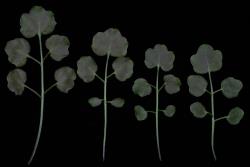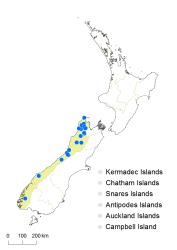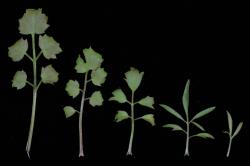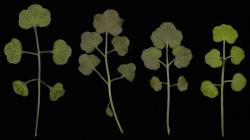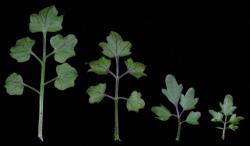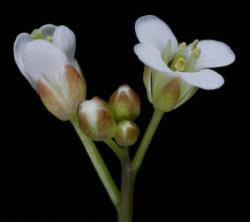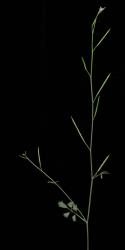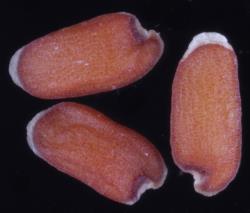Perennial herb, single rosette or with short lateral branches, stem and branches 1.0–3.0 mm diam. Leaves up to 115 mm long, pinnatisect; lamina 16.0–60.0 × 9.0–32.0 mm, green to green-brown, pinnae midrib and main veins green or red to red-brown on adaxial surface, membranous, glabrous, matt. Terminal pinna 5.5–30.0 × 8.0–29.0 mm, reniform, broadly reniform, to orbicular-reniform, margin with 1–7 shallow lobes and 1–7 conspicuous hydathodes, apex obtuse to truncate with a conspicuous hydathode, base weakly to strongly cordate. Lateral pinnae 2–4, 3.1–14.0 × 2.4–17.0 mm, reniform, orbicular-reniform, or broadly elliptic, margin with 1–5 shallow rounded lobes and 1–5 conspicuous hydathodes or entire, apex obtuse with a conspicuous hydathode, base cordate to obtuse, petiolule (0.6–)3.0–5.3 mm long; petiole up to 70 mm long. Cauline leaves similar to rosette leaves but smaller, lateral pinnae absent or 2(–4); pinnae reniform, orbicular-reniform to elliptic, lobes shallowly rounded to narrowly triangular, hydathodes conspicuous. Inflorescence with 1–8 racemes, each raceme up to 17-flowered; peduncle up to 400 mm long, 1.0–2.2 mm diam. at base, green or green-brown and mottled red-brown, spreading to ascending, glabrous. Pedicels 4.0–17.0 mm long, 0.4–1.0 mm diam., terete, glabrous. Sepals 2.0–3.2 × 0.7–1.3 mm, elliptic-oblong to broadly elliptic, ± saccate, green or green-brown, glabrous, margin white and membranous, apex obtuse, base truncate. Petals 3.0–6.0 × 1.5–2.7 mm, white, limb obovate to broadly elliptic; apex obtuse; base attenuate to cuneate, tapering to a 0.5–1.2 mm-long claw. Stamens 6; median filaments 4, 2.5–4.1 mm long; lateral filaments 2, 1.8–3.3 mm long; anthers 0.4–0.8 mm long, cream to pale yellow, when dehiscent held at a similar height to or slightly below the stigma. Ovary 2.8–6.0 mm long, 0.5–1.0 mm diam., ± terete, green, glabrous; ovules 13–24; style 0.3–1.1 mm long, ± terete; stigma 0.3–0.5 mm diam. Siliques (8.5–)17.0–43.0 × 1.5–2.3 mm, glabrous, style 1.0–3.0 mm long; valves green to green-brown at maturity; replum 0.4–1.4 mm wide. Seeds 1.5–2.4 mm long, (0.6–)1.0–1.5 mm wide, 0.4–0.6 mm thick, oblong to oblong-elliptic, green to green-brown; apex broad, obtuse, with prominent wing c. 0.1 mm wide present at apex.
Cardamine unguiculus is distinguished from C. polyodontes in having entirely glabrous leaves with 1–2 pairs of lateral leaflets, terminal and lateral leaflets with prominent marginal hydathodes and 2–7 shallow angular or weakly rounded lobes, narrower sepals, shorter and narrower petals, and seeds with a prominent apical wing.
South Island: Western Nelson, Westland, Fiordland.
Cardamine unguiculus grows in a variety of habitats including a sphagnum swamp, on damp rock outcrops, and on limestone in damp hollows and tussockland.
Cardamine unguiculus is assessed as having a conservation status of At Risk—Naturally Uncommon, with the qualifiers Data Poor and Sparse (de Lange et al. 2018). The qualifier Sparse is applied because current knowledge indicates that C. unguiculus comprises mostly small and scattered populations. The qualifier Data Poor indicates additional information is required on the number and size of the populations.
Flowering November–March; Fruiting November–August.
Leaf colour varies in Cardamine unguiculus, with this variation often occurring in the same geographical area, such as at Blue Bottle Creek, Lake Kaniere, Westland. At this site, some plants have leaves that are green with inconspicuous green veins, and others are green-brown with conspicuous red to red-brown veins.
Some of the Nelson collections of Cardamine unguiculus were previously identified as belonging to the tagname entities C. “Tussock Race” (e.g., CHR 366094) or C. “Glossy Leaf” (e.g., CHR 419070); collections referrable to C. “Tussock Race” are herein named as C. polyodontes and those of C. “glossy leaf” as C. chlorina.



